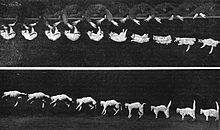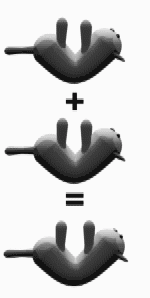Right reflex of the cat

The cat's righting reflex means that cats can survive a fall from a great height unscathed. This trait has earned domestic cats the proverbial reputation of having seven or nine lives.
Fall and consequences
A cat can turn in the air and thus assume the optimal position for hitting the ground. This ability is known as the righting reflex . It matures after the cat is five weeks old. Since the turning process takes time, a drop height of at least three meters is required to complete it .
Since cats are light in relation to the air resistance of their fur and their cross-sectional area, their maximum fall speed is only around 100 kilometers per hour. By stretching out their legs and tail after the stabilization phase, they also help to increase their air resistance when falling. When the speed limit of 100 km / h is reached, the air resistance compensates for the weight and the fall is no longer accelerated. The exact limit speed also depends on the size and weight of the cat and is reached after about 30 meters if it falls. Falling from a great height (e.g. from high-rise buildings) no longer increases the risk of injury.
Procedure in the case
A rotating body has angular momentum . The angular momentum is a conserved quantity and cannot be created or lost from nothing. According to the law of angular momentum, a body can only change its speed or direction of rotation and thus its angular momentum by absorbing or emitting angular momentum through interaction with the environment. A falling and originally non-rotating cat that would like to change its position in space by performing a rotation would have to repel itself at a fixed point to initiate and end the rotation, which is not possible in free fall.
When the cat turns, the tail only takes on a controlling and stabilizing function by counteracting the turning movement by rowing when it reaches the normal position. Even cats without a tail are able to line up in the fall.
Before landing on the ground, the cat stretches its legs and arches its back; the tail also stabilizes this final phase of the fall.
1. Explanation of rotation
In order to change its alignment in space, the cat alternately pulls its limbs and stretches them out again ( pirouette effect ), while at the same time twisting its body parts against each other.
By pulling in the paws, the cat reduces the moment of inertia of the front part of the body. If the cat now turns the front half of the body over the shoulder in the direction of fall, the rear part of the body turns in the opposite direction to compensate. The rear legs are stretched out so that the moment of inertia of the rear part is greater. This therefore turns around less than the front part. During this maneuver, the cat's flexible spine acts as an axis of rotation around which the halves of the body twist.
If the cat now extends its front legs and pulls in the rear legs, the ratio of the moments of inertia is reversed, so that the rear part can be caught up while the front part swings back by a smaller angle of rotation.
2. Explanation of rotation
In addition to the sequence of movements described above, the cat seems to use a second mechanism for turning, which is superimposed on the first sequence.
By kinking its spine, the cat has the opportunity to rotate its front and rear parts in the same direction using the hip muscles. The spine can almost form a right angle.
In the sequence of movements described above, the spine functions as a swivel joint around which the front and rear parts are rotated in opposite directions. On the other hand, the spine can be compared with an angular gear after bending , which connects the front and rear parts with one another via bevel gears .
Due to the flexibility of vertebrae and intervertebral discs , the cat can decide for itself at what point in time it would like to turn the front and rear parts in the same or in opposite directions. However, she is only able to rotate in the same direction if her spine is bent. The two halves of the body roll off one another at the kink like two bevel gears.
While in the sequence described above the angular momentum of the two body halves is canceled out due to the opposing rotation, when the body halves are rotated in the same direction, the entire body has to perform a compensatory movement in order to compensate for the angular momentum: the V-shaped cat's body rotates as a whole in opposite directions rotation for the hull of the cat. (These two opposite directions of rotation are also only possible if the spine is bent. If the body is stretched out, the two rotational movements would cancel each other out.)
The illustration on the right shows the synchronous rotation of the two halves of the body initiated by the cat through its hip muscles in the animation above. The animation in the middle shows the compensating rotation of the kinked body in its entirety, through which the angular momentum of the rotation of the body halves when the cat falls weightlessly is compensated. In this animation, the rotational movement of the body halves has not been shown for a better understanding of the two rotational movements occurring separately from one another. The animation below shows the actual sequence of movements to be observed: Here, the rotational movements of the body halves are superimposed on the compensatory rotational movement of the entire body.
Injuries
With the ability to roll around in the fall and the maximum speed of fall, cats can basically survive falls from great heights. However, falling animals often cause serious and sometimes fatal injuries. Broken bones, upset paws, concussion, knocked out teeth and internal injuries are consequences that occur especially when falling on concrete, stones or obstacles.
Research history
As early as 1894, the French scientist Étienne-Jules Marey first made slow-motion photos (60 frames per second) of a falling cat, which turns in the air and lands on its paws. Falling Cat is a one-minute short film that was shot in the Bois de Boulogne Park in Paris . This is probably the first ever film with a moving cat.
In the 1960s, Thomas R. Kane, a professor at Stanford University , was researching the motion patterns of cats in the case. Since NASA assumed that the results of the Kane investigations could have relevance for the locomotion of astronauts in weightlessness , they financed Kane a project to develop such motion sequences. For this purpose, the movements of cats on trampolines were rehearsed by athletes. Kane and his experiments were featured in Life Magazine in 1968 under the heading A Copycat Astronaut .
In an article that appeared in the Journal of the American Veterinary Medical Association in 1987 , veterinarians described 132 cases of cats falling on the street from a great height (5.5 stories average) in New York and being admitted to a veterinary clinic. 90 percent survived the fall, but some with serious injuries. The statistical results obtained from the examinations were distorted because animals that had already died were no longer admitted. Nevertheless, the study was interesting: the chance of survival initially decreased with increasing height, but from the 7th floor it increased again a little.
In July 2004, a cat-like robot was tested in a Boeing Stratotanker , which simulates weightlessness during parabolic flight . The concept of Gregory Ojakangas, a physics professor at Drury University in Springfield , USA , was based on investigations into the fall technique of cats.
“If you drop a cat upside down, it will always land on its feet - without any angular momentum. She doesn't kick in the air because that would cause her to spin. Instead, she just stretches her upper body, rotates it, then contracts her lower body and rotates it in the opposite direction. From this point of view, our idea is not particularly new. Nature has mastered this trick for millions of years. "
In an article in the journal Nature on August 12, 2004, mathematician Ian Stewart showed the similarities between the movements of a double pendulum , the vibrations of a carbon dioxide molecule and the falling of a cat - all summarized under the term " monodromy ".
Other types of cats
Not only domestic cats have the ability to land on their four paws. Larger representatives of the cat family, such as caracals , jaguars or lions , also master the rotation in the case.
Resultant sayings
- A cat always falls on its feet / paws
- Cats have seven (or nine) lives
Web links
- Video: Systems Physics: Cats always fall on their paws on YouTube
- Video: Galileo - Why do cats always land on their paws?
Individual evidence
- ↑ a b Gerd Ludwig , Katzenssprache: Learning to understand step by step, ISBN 978-3-8338-5489-7 , Gräfe and Unzer , 2016, p. 19
- ↑ a b c d e A cat always falls on its feet. In: Innsbruck Physics - Research Center at the University of Innsbruck .
- ↑ a b Christoph Drösser : Katzensprünge. In: Die Zeit , May 3, 2007.
- ↑ Rainer Köthe and Reiner Zieger, Was ist was , Tessloff Wissen, Volume 59, ISBN 978-3-7886-0299-4 , Tessloff Verlag , 1991, p. 32f.
- ↑ a b c Not only house cats always land on their paws - the desert lynx also manages the screw. In: Watson , April 7, 2014.
- ↑ Hardy Fink: An insight into the Biomechanics of Twisting Archived from the original on May 28, 1998. In: USA Gymnastics (Ed.): Technique . February 17, 1997. Retrieved December 26, 2007.
- ↑ Carlos I. Calle: Superstrings and Other Things: A Guide to Physics . CRC Press , October 10, 2001, ISBN 9780750307079 , pp. 106, 107 (accessed June 4, 2008).
- ↑ Thomas Kane, MP Scher: A dynamical explanation of the falling cat phenomenon . In: International Journal of Solids and Structures . 5, No. 7, 1969, pp. 663-670. doi : 10.1016 / 0020-7683 (69) 90086-9 .
- ↑ Nadine Pensold: Why do cats always land on their paws? In: Märkische Allgemeine , June 23, 2014.
- ↑ Falling Cat (1894) in the IMDb database.
- ↑ Lauren Davies, The experiment to determine whether an astronaut could fall like a cat , April 2, 2012, Gizmodo and A Copycat Astronaut: Formula for a four-point landing , Life Magazine , August 16, 1968, pp. 77f .
- ↑ a b Copied from cats: Robot practices free fall without angular momentum , July 14, 2004, EDN .
- ^ Ian Stewart , Nonlinear Dynamics: Quantizing the Classical Cat , in: Linley Erin Hall, The Laws of Motion: An Anthology of Current Thought , ISBN 978-1-4042-0408-9 , Rosen Publishing Group, 2008, pp. 89ff
- ↑ Hans Schemann, Synonym dictionary of German phrases , ISBN 978-3-11-021791-9 , Walter de Gruyter , 2012, p. 315.
- ↑ Where does the expression come from: cats have seven lives? at wasistwas.de (Tessloff Verlag).
- ↑ Do cats have seven or nine lives? Retrieved March 4, 2020 .


